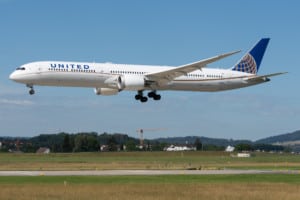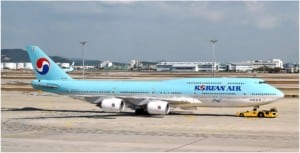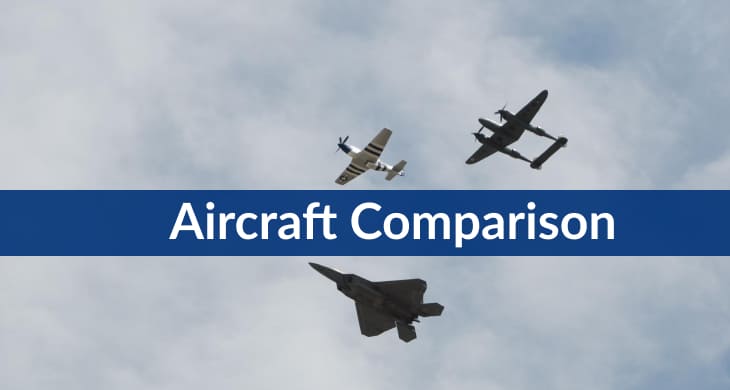The Boeing 777 and 747 are the world’s most commonly used commercial airliner models. That means they can often be seen in the skies above us. And this article will stack the Boeing 787 vs 747 against each other and find the winner.
| Aircraft: | Boeing 787-10 Dreamliner | Boeing 747-8 |
|---|---|---|
| Photo: |
 |
 |
| Country: | United States | United States |
| Manufactured: | from: 2015 to: Present | from: 2008 to: Present |
| ICAO: | B78X | B748 |
| Price: | $338.4 million | $418.4 million |
| Avionics: | Rockwell Collins next generation avionics | Rockwell Collins Avionics |
| Engine: | 2x Rolls-Royce Trent 1000 or General Electric GEnx-1B | 4x General Electric GEnx 2B67 |
| Engine Type: | Turbofan | Turbofan |
| Power: | 76,000 pound-force | 66,500 pound-force |
| Max Cruise Speed: |
515 knots 954 Km/h |
533 knots 987 Km/h |
| Approach Speed (Vref): | 140 knots | 145 knots |
| Travel Range: |
6,430 Nautical Miles
11,908 Kilometers |
8,000 Nautical Miles
14,816 Kilometers |
| Fuel Economy: |
0.22 nautical mile / gallon 0.108 kilometres / litre |
0.12 nautical mile / gallon 0.059 kilometres / litre |
| Service Ceiling: | 43,000 feet | 43,000 feet |
| Rate of Climb: |
3000 feet / minute 15.24metre / second |
2500 feet / minute 12.70metre / second |
| Take Off Distance: |
2800 metre 9,186.24 feet |
3190 metre 10,465.75 feet |
| Landing Distance: |
1520 metre 4,986.82 feet |
2680 metre 8,792.54 feet |
| Max Take Off Weight: |
254,011 Kg 559,993 lbs |
447,696 Kg 986,991 lbs |
| Max Landing Weight: |
201,848 Kg 444,994 lbs |
312,072 Kg 687,994 lbs |
| Max Payload: |
57,277 Kg 126,273 lbs |
76,067 Kg 167,697 lbs |
| Fuel Tank Capacity: |
33,399 gallon 126,429 litre |
63,034 gallon 238,609 litre |
| Baggage Volume: |
190.3 m3 6,720 ft3 |
161.5 m3 5,703 ft3 |
| Seats - Economy: | 440 seats | 467 seats |
| Seats - Business Class: | 290 seats | 600 seats |
| Seats - First Class: | - | 467 seats |
| Cabin Height: |
2.5 metre 8.20 feet |
2.39 metre 7.84 feet |
| Cabin Width: |
5.49 metre 18.01 feet |
6.1 metre 20.01 feet |
| Cabin Length: |
62 metre 203.41 feet |
63.25 metre 207.51 feet |
| Exterior Length: |
68.3 metre 224.08 feet |
76.25 metre 250.16 feet |
| Tail Height: | 17.02 metre - 55.84 feet | 19.51 metre - 64.01 feet |
| Fuselage Diameter: |
5.77 metre 18.93 feet |
6.49 metre 21.29 feet |
| Wing Span / Rotor Diameter: |
60.12 metre 197.24 feet |
68.4 metre 224.41 feet |
| Wing Tips: | Raked Wingtips | Raked Wingtips |
| More Info: | Boeing 787-10 Dreamliner | Boeing 747-8 |
|
Data presented is for entertainment purposes and should not be used operationally.
|
Other Boeing 787-10 Dreamliner comparisons:
Other Boeing 747-8 comparisons:
About the Boeing 787-10 Dreamliner
This is the most advanced aircraft manufactured by Boeing company. It has a seating capacity of 359 to 440 passengers with a two-class configuration and provides excellent comfort.
Why was it developed and built?
Boeing 787 Dreamliner was built as a successor to the famous Boeing 747. It could seat up to 440 passengers in a three-class configuration and had a range of over 6,430 mi. The 747 was very successful, but airlines soon wanted a bigger aircraft that could fly further distances and carry more passengers.
What purpose does it serve?
The Boeing 787 Dreamliner serves several purposes for the airlines that operate it. It is a widebody aircraft capable of carrying more passengers and cargo than its predecessor. It has a long range and can fly impossible routes with other aircraft models.
About the Boeing 747-8
The Boeing 747 is a popular airliner that still dominates the commercial airline industry in many regions. It has a seating capacity of 276 to 467, depending on the configuration. Plus, it is a long-range aircraft capable of flying routes up to 7,730 mi.
Why was it developed and built?
The Boeing 747 was developed and built to answer the airline’s need for larger airliners that could fly further distances. It was a revolutionary aircraft when introduced with its widebody design, two decks, and much larger capacity than any other commercial airliner at the time.
What purpose does it serve?
The Boeing 747 is an ideal airline workhorse due to its large capacity and excellent range. It allows airlines to operate nonstop flights from one continent to another, making it an economical choice for long-distance travel.
How are the Boeing 787 Dreamliner and Boeing 747 different?
Though they may appear similar at first glance, these two planes are pretty different. Let’s get a closer look at how the Boeing 787 Dreamliner and Boeing 747 differ:
Size Matters
One of the most immediately striking differences between the Boeing 787 Dreamliner and the Boeing 747 is size. The Boeing 787 Dreamliner is a widebody plane, while the Boeing 747 is a jumbo jet.
This means the Boeing 787 Dreamliner can seat more passengers (359-440, depending on the configuration) than the Boeing 747 (276-416, depending on the configuration).
The Boeing 787 Dreamliner also has a wider cabin than the Boeing 747, which provides increased elbow room and legroom for passengers. In short, if you’re looking for a spacious flight, the Boeing 787 Dreamliner is your best bet.
Fuel Efficiency Favors the Boeing 787 Dreamliner
The Boeing 787 Dreamliner was designed with fuel efficiency in mind, so it uses less fuel than its predecessor. This difference in fuel usage results in significant cost savings for airlines operating 787s.
Not only does this make flights on a Boeing 787 Dreamliner cheaper for passengers, but it also makes them more eco-friendly. If you want to minimize your carbon footprint, flying on a Boeing 787 Dreamliner is a great way to do it.
The range is Key for Long-Haul Flights.
Another critical difference between these two aircraft models is range. The Boeing 787 Dreamliner has a range of 11,910 km, while the Boeing 747 has a range of 14,320 miles.
So, if you’re looking to travel long distances without stopping, you’ll want to fly on a Boeing 747. On the other hand, if your travel plans are a bit more modest, you’ll be fine flying on a Boeing 787 Dreamliner.
How are the Boeing 787 and Boeing 747 similar?
Despite their differences, the Boeing 787 Dreamliner and Boeing 747 have some things in common.
- Both planes are widebody aircraft carrying many passengers and cargo, with a two-deck configuration.
- Both planes are equipped with advanced technology that provides improved safety levels, such as GPS navigation systems, terrain-avoidance systems, and advanced autopilot systems.
- Additionally, both planes are powered by four turbofan engines and can fly on long-haul routes.
- Finally, both planes have been certified by the FAA and are considered reliable aircraft by airlines.
The Boeing 787 Dreamliner and Boeing 747 are excellent aircraft with many similarities and differences.
What’s better about the Boeing 787?
There are plenty of reasons to love the Boeing 787 Dreamliner.
- For starters, it’s one of the most reliable planes in the sky, with a strong safety record. It’s also extremely comfortable, with spacious seats and ample legroom.
- And thanks to its widebody design, the Boeing 787 Dreamliner has a generous luggage capacity, making it ideal for long-haul flights.
- But what sets the Boeing 787 Dreamliner apart is its range. With a maximum range of nearly 11,000 miles, the 787 can fly nonstop!
So whether you’re looking for reliability, comfort, or range, the Boeing 787 Dreamliner has you covered.
What’s better about the Boeing 747?
The Boeing 747 is a large-capacity, widebody jetliner. It was the first “jumbo jet,” revolutionizing air travel with its larger passenger capacity and faster travel times.
- Today, the Boeing 747 is still one of the most famous aircraft for long-distance travel and continues to be updated with new technology.
- One of the most notable features of the Boeing 747 is its distinctive shape. The upper deck is more expansive than the main deck, giving the aircraft a unique profile.
- The Boeing 747 also has a large tail fin, which helps to stabilize the aircraft at high speeds. In addition to its size and shape, the Boeing 747 is also known for its four engines.
- This configuration provides extra power and safety, allowing the aircraft to take off and land on shorter runways.
The Boeing 747 is an iconic aircraft and remains one of the most popular options for long-distance travel. Thanks to its size, speed, and range, the Boeing 747 is a favorite among passengers and airlines alike.
Conclusion
The Boeing 787 Dreamliner and Boeing 747 are two very different aircraft models that each offer unique benefits to flyers. Think about them in terms of size and capacity, fuel efficiency, comfort, range, and reliability when deciding the winner. Finally, remember that the best aircraft depends on what you want in terms of features and performance.


